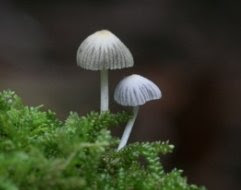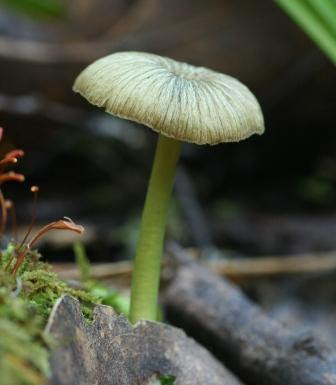 Pholiota sp.
Pholiota sp.Friday, May 30, 2008
Thursday, May 29, 2008
The four-legged Katydid

The katydid, which has been living on the Correa for at least a month, is not the most dynamic of insects, but its almost motionless disposition does allow for close photographic scrutiny. As mentioned below, in the daytime it stands, head downwards, on a leaf; in the evenings this mostly nocturnal species ventures 7cm to the top of the Correa. I know it is capable of fast movement because during the sudden onset of torrential rain and hail last weekend it moved quickly to underneath the leaf.
Every day I check its whereabouts and because it is so well camouflaged this can take a while. A few weeks ago I thought I’d lost my little friend, but it had moved from its hitherto favourite resting spot to a lower leaf.
Today I thought the worst had happened but eventually, late in the afternoon, I found her (him) well hidden in the middle of the bush.
Something traumatic occurred last night and the katydid no longer has six legs.
One of the defense strategies of orthopterans (grasshoppers and crickets) is their ability to sacrifice a limb that's grasped by a predator by contracting a special muscle at the base of the limb. A small diaphram immediately closes the wound to prevent infection or blood loss.
Tuesday, May 27, 2008
Bassian Thrush (Zoothera lunulata)
 Bassian Thrush
Bassian ThrushBassian Thrushes (Zoothera lunulata) dwell in the shady forests of the gullies and paperbark swamps. Their beautiful fluty song heralds the day long before sunrise. It is occasionally heard late in the evenings and on dark overcast days.
Most of the year these secretive birds keep to the gully where they breed. I have only once found a nest, a large cup-shaped structure built against the trunk of a dogwood. In autumn they move into the open forests to forage for ground dwelling invertebrates, especially worms. They use their strong fleshy legs and feet to pound and scratch the ground when searching for prey.
Sometimes their presence is revealed by a warning whistle, a note so high that it’s beyond the hearing capacity of many people. Seeing the birds can be difficult, as their scalloped markings (their Latin species name ‘lunulata’ means 'marked with little moons') on their breast and back blend well with the leaf litter in which they search for food.
It was undoubtedly the activities of a Bassian Thrush that revealed the bright red flower of the fairy lantern (Thismia rodway).
Monday, May 26, 2008
Fairy lanterns (Thismia rodwayi)
 Fairy lantern Thismia rodwayi
Fairy lantern Thismia rodwayiI first founda colony of fairy lanterns Thismia rodway in the gully in 2004.
Thismias, or fairy lanterns, are succulent herbs that belong to the Burmanniaceae family; they are closely related to orchids. They grow almost entirely underground, are usually leafless, lack chlorophyll and are thus unable to photosynthesise. To obtain the nutrients they require, these saprotrophic plants rely on a symbiosis with fungi. However, as fungi are also unable to photosynthesize, a photosynthetic plant must also be involved in the association. It is possible that, like the underground flowering orchid of Western Australia, Rhizanthella gardneri, which is linked to a melaleuca species via its mycorrhizal fungus, thismias may be associated with Olearia argophylla or Bedfordia.
Little is known about the distribution and ecology of these rarely seen plants and their method of pollination remains a mystery. It is thought that pollen may be spread by termites, ants, flies or other small invertebrates that inhabit the litter layer. The strong fishy smell emanating from the flower may serve to attract litter layer detritivores to perform this function.
Thismias are mostly found throughout the tropics, with 32 species in tropical America, 25 in Southeast Asia, 19 in tropical Asia, and one each in Japan, the US state of Illinois and New Zealand. In some cases the story of their discovery is as intriguing as the plants themselves.
In 1912, Thismia americana was collected from a low sand prairie on the Chicago Lake Plain in Illinois by Norma Pfeiffer, then a botany student. She found more plants in the same area the following year, but that was the last reported sighting. This is hardly surprising given that the site is now covered in landfill and is highly industrialised.
In 2000, researchers surveying the botanical riches of Jade Mountain in the Yushan National Park, which covers Taiwan’s central mountain range, collected a white tentacled thismia which they named Thismia taiwanensis. This newly described species appears to be endemic to the area, having never been found elsewhere in Taiwan or on the Chinese mainland.
In 2001, a third thismia species for Australia was found by fungi enthusiast, Pat Jordon, at Bundanoon, in New South Wales. At first it was mistaken for a coral fungus (Clavaria sp.) because of its tentacle-like projections. It has since been named Thismia clavariodes because of this resemblance.
Thursday, May 22, 2008
Pink Robin (Petroica rodinogaster)
 Pink Robin (adult male)
Pink Robin (adult male)  Pink Robin (sub adult male)
Pink Robin (sub adult male)Pink Robins occur in the wet gullies and rainforests of the southern mainland of Australia, but Tasmania is the species’ stronghold. At Black Sugarloaf they breed in the swamp and gullies and build their nests in the upper fork of a small tree such as a dogwood, musk or paperbark.
Their nests are well constructed and well hidden and are unlikely to be seen unless a bird is building the nest or feeding young. Bark strips are bound with spiders’ web and the outside of the nest is decorated with mosses, liverworts and flakes of lichen.
I was fortunate one late January afternoon to watch and photograph a family of several young birds being fed by the female. The male watched but seemed to take no part in the feeding. While the young were still in the nest, however, he did do his share of food gathering.
Wednesday, May 21, 2008
Eastern Spinebill
 Eastern Spinebill (juvenile)
Eastern Spinebill (juvenile)Two plants flower profusely in the winter months, the mountain correa (Correa lawrenciana) (on which the katydid is living) and the common heath (Epacris impressa). Both are visited by the Eastern Spinebill, a small honeyeater found throughout southeastern Australia.
There is a resident population of Eastern Spinebills that breed at Black Sugarloaf each year. When the heath and correa are flowering the resident population is augmented by nomadic birds that move in from other areas to feed on the rich nectar source provided by these flowers.
Tuesday, May 20, 2008
Fungi
A colourful array of fungi starts to appear after the first rains in Autumn.
I have been documenting the species that occur at Black Sugarloaf since 2000 and every year I add more names to the list, which now numbers over 200 species.
Here is a selection of the species found growing in May.
 Coprinus sp.
Coprinus sp.
 Mycena sp.
Mycena sp.
 Entoloma sp.
Entoloma sp.
 Chlorociboria sp.
Chlorociboria sp.
 Mycena interrupta
Mycena interrupta
 Mycena clarkeana
Mycena clarkeana
 Mycena nargan
Mycena nargan
 Rickenella fibula
Rickenella fibula
I have been documenting the species that occur at Black Sugarloaf since 2000 and every year I add more names to the list, which now numbers over 200 species.
Here is a selection of the species found growing in May.
 Coprinus sp.
Coprinus sp. Mycena sp.
Mycena sp. Entoloma sp.
Entoloma sp. Chlorociboria sp.
Chlorociboria sp. Mycena interrupta
Mycena interrupta  Mycena clarkeana
Mycena clarkeana Mycena nargan
Mycena nargan Rickenella fibula
Rickenella fibula
Saturday, May 17, 2008
Mountain Correa (Correa lawrenciana)
Katydid (Caedicia simplex)

On April 22nd a katydid nymph (Caedicia simplex) was spotted in a Correa lawrenciana (native fuschia) near the front door. Most insects have become inactive since the onset of cooler weather, so the cold-tolerant katydid has been the subject of close photographic scrutiny.
Unlike their terrestrial relatives, the grasshoppers, katydids spend most of their time in trees or shrubs. As they ingest material from their food plant their colours develop to match the plant on which they feed and rest.
The peregrinations of this particular katydid nymph are fairly limited. Some evenings it ventures 7 cm to the top of the Correa, but most of the time it stands, head downwards, on a leaf.
There was a moment of high excitement on May 3rd when it shed its exoskeleton! Nymphs (depending on the species) take weeks or months to reach full size and will shed their exoskeletons several times while they grow. Eventually wing buds, then wings, develop. I'm expecting that an adult, fully winged katydid will venture further than the Correa...
Male katydids ‘sing’ to attract females; they stridulate by rubbing together specialized veins on their wings. The vigour of their singing is dependent on temperature. To attain the necessary thoracic temperature for stridulation male katydids (most females are silent) shiver.
A 74mm katydid species that lives in the forests of North America, Neoconocephalus robustus, must get its flight muscles to 30 degrees before it can belt out its apparently ear piercing call. The females seem to prefer the loudest (and hottest) males.

Katydids "hear" with their tympanum, a small slit in their tibia (visible in the above picture) covered by a pressure-sensitive membrane.
Subscribe to:
Posts (Atom)











